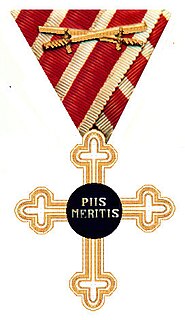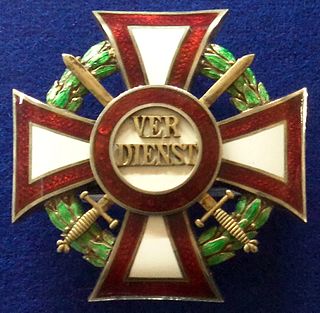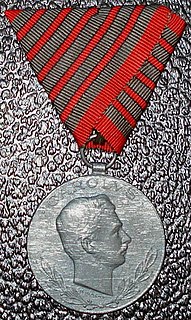 W
WThis is a list of Orders, decorations, and medals of Austria-Hungary.
 W
WThe Medal for Bravery was a military decoration of Austria-Hungary established in 1789 and awarded for bravery in battle until the dissolution of the Austro-Hungarian Empire in 1918.
 W
WThe Karl Troop Cross was instituted on 13 December 1916 by Emperor Karl I of Austria-Hungary. The cross was awarded until the end of the First World War to soldiers of the Austro-Hungarian Army, regardless of rank, who had been with a combatant unit for at least twelve weeks and who had actually served at the front.
 W
WThe Military Merit Cross was a decoration of the Empire of Austria and, after the establishment of the Dual Monarchy in 1867, the Empire of Austria-Hungary. It was first established on October 22, 1849 and underwent several revisions to its design and award criteria over the years of its existence. It became obsolete in 1918 with the dissolution of the Austro-Hungarian Empire.
 W
WThe Military Merit Medal was a military decoration of the Empire of Austria-Hungary. It was founded by Emperor Franz Joseph I on March 12, 1890. The Military Merit Medal is often referred to as the "Signum Laudis" after the inscription on the reverse of the medal.
 W
WThe Austrian Imperial Order of the Iron Crown was one of the highest orders of merit of Austria and Austria-Hungary until 1918. It was re-established in 1815 by Emperor Franz I of Austria. The original Order of the Iron Crown had previously been an order of the Napoleonic Kingdom of Italy.
 W
WThe War Cross for Civil Merits was a civil award of Austria-Hungary. Established on 16 August 1915 by Emperor Franz Joseph I of Austria, it recognized civilian war service during World War I. The cross could also be awarded to military officers for their contributions to the war but were not directly involved in combat operations.
 W
WThe Wound Medal was a decoration of the Empire of Austria-Hungary. It was established on August 12, 1917 by Emperor Karl and was the last medal to be officially founded in the empire.